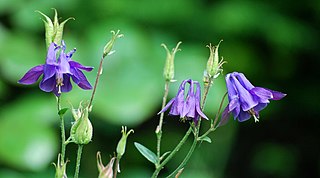
Aquilegia is a genus of about 60–70 species of perennial plants that are found in meadows, woodlands, and at higher altitudes throughout the Northern Hemisphere, known for the spurred petals of their flowers.

Dryas octopetala, the mountain avens, eightpetal mountain-avens, white dryas or white dryad, is an Arctic–alpine flowering plant in the family Rosaceae. It is a small prostrate evergreen subshrub forming large colonies. The specific epithet octopetala derives from Greek octo 'eight' and petalon 'petal', referring to the eight petals of the flower, an unusual number in the Rosaceae, where five is the normal number. However, flowers with up to 16 petals also occur naturally.

Aquilegia formosa, the crimson columbine, western columbine, or (ambiguously) "red columbine", is a common wildflower native to western North America, from Alaska to Baja California, and eastward to Montana and Wyoming.

Aquilegia canadensis, the Canadian or Canada columbine, eastern red columbine, or wild columbine, is a species of flowering plant in the buttercup family Ranunculaceae. It is an herbaceous perennial native to woodland and rocky slopes in eastern North America, prized for its red and yellow flowers. It readily hybridizes with other species in the genus Aquilegia.

Aquilegia coerulea, the Colorado blue columbine, is a species of flowering plant in the buttercup family Ranunculaceae, native to the Rocky Mountains, USA. Aquilegia coerulea is the state flower of Colorado.
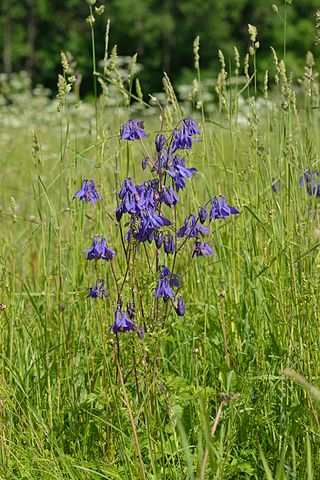
Aquilegia vulgaris is a species of columbine native to Europe with common names that include: European columbine, common columbine, granny's nightcap, and granny's bonnet. It is a flowering herbaceous perennial plant growing to 1.2 m tall, with branched, thinly hairy stems. The leaves are biternate; each leaf has three groups of three leaflets. The flowers, in various shades of purple, blue, pink and white, are pendent or horizontal with strongly hooked spurs, and appear in early summer.

Adonis pyrenaica, common name Pyrenean pheasant's eye, is a species of plant in the family Ranunculaceae.

Pulmonaria longifolia, is a semi-evergreen clump-forming herbaceous perennial plant, native to western Europe, including Britain, France, Spain, Portugal. It grows in semi-shaded habitats, such as woodland and scrub, to 2000 m above sea level.

Horminum is a genus of flowering plants in the family Lamiaceae, comprising a single species, Horminum pyrenaicum. Common names include dragonmouth and Pyrenean dead-nettle.

Ramonda myconi, the Pyrenean-violet or rosette mullein, syn. R. pyrenaica, is a species of flowering plant in the family Gesneriaceae, which is a relictual endemite of shady, rocky places in the Pyrenees and north eastern Spain. It is a rosette-forming evergreen perennial growing to 10 cm (4 in) high by 20 cm (8 in) broad, with oval, crinkled leaves. Five-petalled purple flowers with prominent yellow anthers appear on leafless stems in spring.
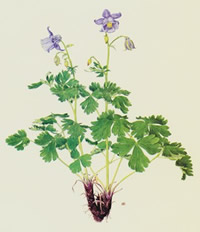
Aquilegia nuragica, commonly called Nuragica columbine, is a perennial species of plant in the family Ranunculaceae. It is endemic to Italy, on the island of Sardinia.
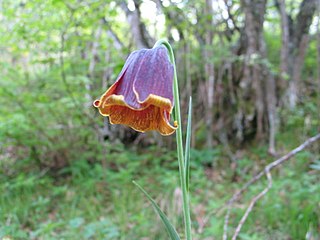
Fritillaria pyrenaica is a species of flowering plant in the lily family Liliaceae, native to the Pyrenees in Spain and France. Common names include Pyrenean fritillary and Pyrenean snake's-head. It is a bulbous perennial growing to 45 cm (18 in). The pendent, bell-shaped flowers are borne in spring. They have recurved tepals which are purple tinged with brown and yellow. Like other species in this genus, notably F. meleagris, they are strongly chequered.
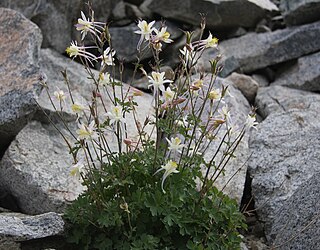
Aquilegia pubescens is a high-altitude species of columbine known by the common names Sierra columbine, alpine columbine and Coville's columbine. Its flowers are large and usually a creamy white.

Aquilegia eximia is a species of columbine known by the common names serpentine columbine or Van Houtte's columbine. It is endemic to California, where it grows in the moist forests of the Coast Ranges, usually on serpentine soils.

Aquilegia saximontana, the Rocky Mountain columbine, alpine dwarf columbine, dwarf blue columbine, or alpine columbine, is a perennial plant that comes from the buttercup family, Ranunculaceae.
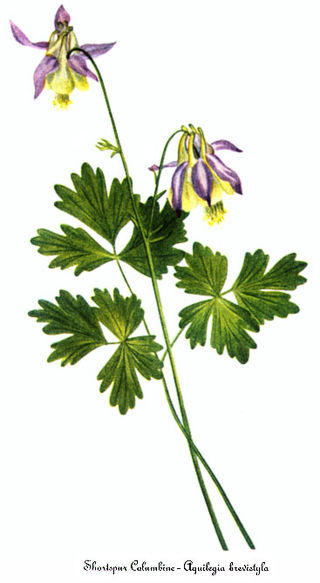
Aquilegia brevistyla is a species of flowering plant in the buttercup family known by the common name smallflower columbine. It is native to northern North America, where it has a disjunct distribution. Most of its range extends from Alaska through much of Canada, and it also occurs in a few areas in the contiguous United States, such as the Black Hills of South Dakota and central Montana. It is most common in eastern Alaska, Yukon, the southern Northwest Territories, and northern parts of Alberta, Manitoba, and Saskatchewan.
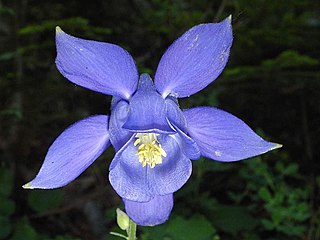
Aquilegia bertolonii, common name Bertoloni columbine, is a species of flowering plant in the family Ranunculaceae, native to Southern France and Italy. Growing to 30 cm (12 in) in height, it is an alpine herbaceous perennial. In early summer each erect stem produces up to four spurred, blue-purple flowers.

Aquilegia longissima, the long-spur columbine, is a rare perennial herb that is native to northern Mexico, Trans-Pecos Texas and southern Arizona. In the original species description by Asa Gray in 1883, Aquilegia longissima is distinguished from the shorter-spurred golden columbine Aquilegia chrysantha based on the extremely long spur over 10 cm long, narrow spatulate petals and very slender spurs that usually hang straight down. The petal spurs have been known to reach 16 cm in length, the longest nectary spurs of any Eudicot. The plants typically flower in the fall after monsoon rains and are found in oak-pine-juniper woodlands in shaded canyons near intermittent streams or on talus slopes.

Aquilegia barnebyi, commonly known as the oil shale columbine or Barneby's columbine, is a perennial species of flowering plant in the buttercup family, with a native range comprising northeastern Utah and northwestern Colorado in the United States. It is named after Rupert Charles Barneby, who, with Harry Dwight Dillon Ripley, first discovered it in Colorado.

Aquilegia sibirica, commonly known as the Siberian columbine, is a species of flowering plant in the genus Aquilegia native to the north-central Asian regions of Siberia, northern Mongolia, Kazakhstan, and Xinjiang. A hardy perennial plant, it prefers temperate environments. The Siberian columbine can be between one and two feet tall with flowers that are lilac-blue and white in color.



















